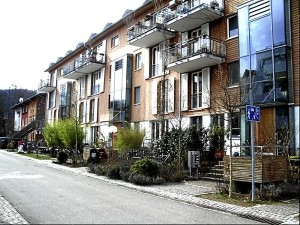Better performing buildings

Passive housing in Freiburg, Germany, the greenest city in the world, has no active system needed to maintain a comfortable temperature. It costs 10 percent more to build, and reduces energy loss—and utility bills—by a staggering 90 percent. Arch. Amado de Jesus & Associates—Green Architecture
What exactly do we mean when we say “better performing buildings”? Is this what many developers are claiming or implying when they market their houses and condo units? Many projects promote their public facilities such as their clubhouses, swimming pools and green spaces. While these are obviously good features, are they enough to qualify the building as a better performing building?
As we continue to build more and more horizontal and vertical housing projects, perhaps now is a good time to evaluate whether these projects conform to green standards.
It takes at least 12 months to be able to make a fairly good assessment of how buildings and houses perform. Within that period, the unit would already have the historical record for its electrical and water usage. And just as important, how the occupants are responding to the living conditions.
Today, thanks to the construction industry’s growing awareness about its role in global warming and climate change, it is now also recognizing the importance of assessing how green-designed buildings actually perform.
It was mentioned a few times here that households could compute their annual energy consumption in kilowatt-hours (kWh) and divide that by the number of square meters of covered and walled floor area. For example an average household with a monthly energy consumption of 250 kWh x 12 uses 3,000 kWh annually. Divide 3,000 kWh by a floor area of say 150 square meters and that gives an energy use index of 20. This is quite close to the energy use index of 15 in the city of Freiburg in Germany, the greenest city in the world.
Asean standards
According to the standards established by the Asean Energy Awards, energy-efficiency index based on occupied air-conditioned areas has a standard of 200 kilowatt hours per square meter per year (kWh/sq m/yr.) for offices, 240 kWh/sq m/yr. for retail/shopping malls, 300 kWh/sq m/yr. for hotels and 400 kWh/sq m/yr. for hospitals.
If we can get all households and building owners and administrators to monitor electricity consumption and to study how to be more energy efficient, we cannot imagine the amount of good that will redound to us.
Indoor-air quality
House and building occupants could also assess indoor-air quality and the frequency of fresh-air change. The average person breathes in 20 kilograms of air per day, much more than the 2 to 3 kilograms of food and water taken each day. One will not take dirty food or water, yet he cannot help but breathe in polluted air. And most of the air we breathe is indoor air.
The need for good indoor-air quality may be obvious. Unfortunately, many of the buildings around us including newly-built ones, do not consider this very basic green element in their design. Examples are long, dark corridors, air-conditoning units and kitchen exhausts discharging fumes along public hallways.
Air pollutants include day-to-day activities like smoking, materials used in construction, appliances and consumer products. Indoor-air pollutants also include dust, asbestos, pollen, mold, bacteria and viruses. Chemical pollutants are deadlier because they are more difficult to detect.
Other concerns of building occupants are lighting levels, acoustics and privacy. Privacy becomes an issue when the level of development in the city results in growing density.
Buildings that are cooled by natural systems impact not only on energy bills, but also on occupants’ comfort and productivity.
Building assessment records reveal that structures that give occupants more thermal comfort are more energy efficient.
Green building rating body
A third-party evaluation group could be commissioned to assess utility bills, maintenance records and actual lay-out of the building aside from interview with building occupants. Building assessment records reveal that structures that give occupants more thermal comfort are more energy efficient.
These building sustainability goals and more are embodied in the rating standards of the Philippine Green Building Initiative or PGBI.
PGBI is a green building rating body composed of building professional organizations such as:
• United Architects of the Philippines (UAP)
• Philippine Society of Ventilating Air Conditioning & Refrigerating Engineers (PSVARE)
• Philippine Chapter of the American Society of Heating Refrigerating & Air Conditioning Engineers (Ashrae)
• Institute of Integrated Electrical Engineers of the Philippines (IIEE)
• Philippine Institute of Interior Designers (PIID)
• Geological Society of the Philippines,
• Heritage Conservation Society
• International Council of Monuments & Sites (Icomos)
PGBI is proud to have started accrediting a number of building professionals through an ongoing seminar program to design and assess green buildings.
PGBI has an order list of prospective client buildings to be designed, and existing buildings to be rated for green standards.
The standards developed by PGBI are more detailed, implementable, measurable and adapted to local climatic conditions.
For comments or inquiries, e-mail amadodejesus@gmail. com.














